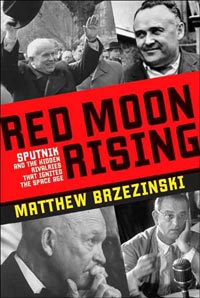|
|
Review: Red Moon Rising
by Jeff Foust
Tuesday, October 9, 2007
Red Moon Rising: Sputnik and the Hidden Rivalries That Ignited the Space Age
by Matthew Brzezinski
Times Books, 2007
hardcover, 304 pp., illus.
ISBN 978-0-8050-8147-3
US$26
Major anniversaries of key events, like last week’s 50th anniversary of the launch of Sputnik, are ideal times to publish books about those events, given the historical selling hook the anniversary provides. Of course, that means that multiple books about the same event can come out at the same time, making it challenging for the reader who is interested in just one account of those events. On the heels of A Ball, A Dog, and A Monkey, one account of the opening salvos of the Space Age (see “Review: A Ball, A Dog, and A Monkey”, The Space Review, October 1, 2007), comes Red Moon Rising, a book that covers many of those same events, but from a somewhat different approach.
Red Moon Rising, by former Wall Street Journal Moscow correspondent Matthew Brzezinski, covers the events in the United States and the Soviet Union from early 1956 through the launch of the first US satellite, Explorer 1, two years later. Brzezinski interlaces the parallel efforts in the two countries to develop missiles that could lob nuclear weapons at each other as well as place satellites in orbit. Much of this history is familiar territory, but Brzezinski does a good job putting it in a broader context, examining the political pressures and struggles in both countries, from the problems Nikita Khrushchev faced with his de-Stalinization efforts to the internecine battles within the US military regarding which service would take the lead in developing new missiles.
| The book makes for compelling reading, as Brzezinski vividly tells the story of the triumphs and struggles that went on in both countries to develop launch vehicles and satellites. |
Red Moon Rising offers few new historical revelations about the events it chronicles, and relies heavily on other published accounts and secondary sources (one exception is a series of interviews the author conducted with Sergei Khrushchev, son of Nikita.) Nonetheless, the book makes for compelling reading, as Brzezinski vividly tells the story of the triumphs and struggles that went on in both countries to develop launch vehicles and satellites. At times the book may be too vivid: a section in the first chapter includes line-for-line dialogue from a visit by Nikita Khrushchev and other Communist Party officials to Sergei Korolev’s design bureau, based only on Sergei Khrushchev’s 50-year-old recollections of the event.
Inevitably, when multiple books come out about the same topic, people will ask how they stack up against each other. While A Ball, A Dog, and A Monkey and Red Moon Rising cover the same events, they are in some respects rather different books. While A Ball, A Dog, and A Monkey tried to humanize the story by focusing on some of the bit players in the drama, Red Moon Rising sticks to the main cast of characters and still manages to turn them into real people with strong, and sometimes conflicting, personalities. That skill is critical, for as much as we may want to focus on the hardware and the chronology of events, it’s the people, with their visions and their conflicts with one another, who made the opening of the Space Age possible.
Jeff Foust (jeff@thespacereview.com) is the editor and publisher of The Space Review. He also operates the Spacetoday.net web site and the Space Politics and Personal Spaceflight weblogs. Views and opinions expressed in this article are those of the author alone, and do not represent the official positions of any organization or company, including the Futron Corporation, the author’s employer.
|
|
